University of Missouri
![]()
Location of University
It is generally understood that the contest for the location of the State University began in 1839, after the passage of the legislative enactment providing for it, but in reality the people of Columbia and Boone County began working for its location on April 7, 1821. On that day, the commissioners for the location of the seat of justice filed their report that Columbia had been selected as such seat, that fifty acres of land and two public squares of ground had been donated for the purpose of the erection of county and town buildings; also the donation of ten acres of land for the erection of bridges across Roche Perche, Moniteau, Hinkson and Cedar creeks, along the St. Charles road; ''also ten acres conditional if the State University be established therein." This ten acre tract was located on the south side of Broadway and just west of the Columbian cemetery, and was marked on the original plat of the town of Columbia as "Seminary land." A part of the ground was many years afterwards purchased by the Columbia school district, and the West ward school building erected thereon.
But even before that early day, the members of the constitutional convention from Howard County, on July 19, 1820, introduced and had adopted as a part of Missouri's first constitution two sections, as follows:
| "Article VI. Of Education.
Section 1. Schools and the means of education shall forever be
encouraged in this state; and the general assembly shall take
measures to preserve from waste or damage such lands as have
been, or hereafter may be granted by the United States for the
use of schools within each township in this state, and shall
apply the funds which may arise from such lands in strict
conformity to the object of the grant; one school or more shall
be established in each township as soon as practicable and
necessary, where the poor shall be taught gratis."
"Section 2. The general assembly shall take measures for the improvement of such lands as have been, or hereafter may be granted by the United States to this state for the support of a seminary of learning; and the funds accruing from such lands by rent or lease, or in any other manner, or which may be obtained from any other source for the purposes aforesaid, shall be and remain a permanent fund to support a university for the promotion of literature, and of the arts and sciences; and it shall be "the duty of the general assembly, as soon as may be, to provide effectual means for the improvement of such lands, and for the improvement and permanent security of the funds and endowments of such institution." |
Contest for University
During the session of the Missouri legislature in 1838-39, Maj. James S. Rollins introduced and had passed an act entitled "An Act to Select a Site for the State University," which was signed and approved by Gov. Lilburn W. Boggs on February 8, 1839 (see Session Acts of Missouri, 1839, pages 184, 185, 186 and 187). Briefly stated, this act provided for the appointment of five commissioners, whose duty it should be to locate a site for the Missouri State University, the location to be at the county seat of one of the following named counties: Cole, Cooper, Howard, Boone, Callaway or Saline.
These commissioners were directed to receive bids from the counties named, and to locate the university in the county which should make the highest bid. The bids were required to be received on or before June 1, 1839, and the commissioners required to meet on that day at Jefferson City. As we all know, Boone County was the highest bidder, and the handsome sum of $117,900 was subscribed by this county, every dollar of which was paid. At that time, this county had a population of 13,361, but three thousand of that number were slaves. The amount thus subscribed and paid was sufficient to have consumed the entire revenues of the county for the next twenty-four years. Missouri was then less than eighteen years old, and the taxable wealth of Boone County was small and her resources limited. Yet these pioneer advocates of higher education determined that they would make their county seat the location of the State University, and they worked to that end day and night. Never were people more thoroughly aroused. Meetings were held throughout the county, in churches, in schoolhouses, on muster grounds and beneath the shades of arching oaks.
Major Rollins, to whom much of the credit has been justly given, was ably assisted by Dr. William Jewell, Dr. Anthony W. Rollins, Dr. Wm. H. Duncan, Jno. B. Gordon, A. W. Turner, Warren Woodson and others, many of whom have descendants still living in this county. The largest subscriptions were for $3,000 each, and were made by Jefferson Garth, Eli E. Bass and Edward Camplin. Mr. Camplin could neither read nor write, and said that he often felt the need of education.
Although Boone County had so large a sum subscribed, Major Rollins was in Jefferson City on the day that the bids were opened, was there for the purpose of raising Boone County's bid, if it became necessary. When it was learned that Boone's bid was nearly $22,000 ahead of that of any other county, Major Rollins hastened from Jefferson City to Columbia on horseback, bringing the good news with him, which was received with more delight and more enthusiasm than the news of any state appropriation ever made afterwards by the general assembly.
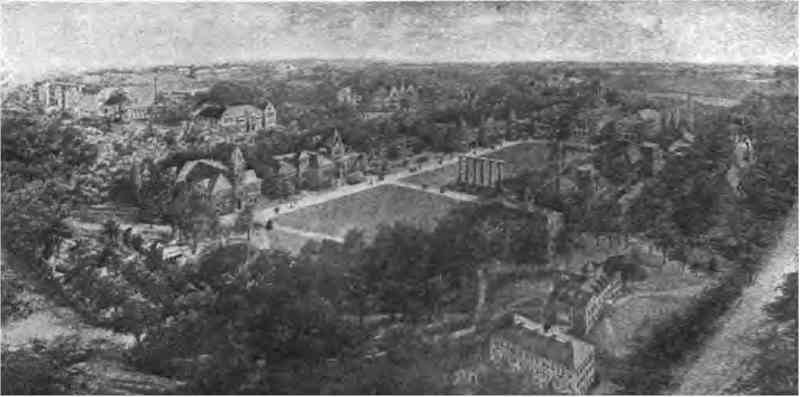
View of the University of
Missouri
Laying Corner Stone op University
By far the greatest event in the history of Boone County was the laying of the comer stone of the main building of the State University, which occurred on July 4, 1840. This was not a local or state event, but rather a national event, as this was the first occasion of its kind west of the Mississippi. After the long contest to secure the university, the people of Boone County were ready to show their appreciation of it by making this occasion an imposing one, and they did. The university building .was erected on two eleven-acre lots (numbers 9 and 27), which were presented to it by John B. Gordon, who was a member of the legislature from Boone county, and who aided Maj. James S. Rollins so materially in securing the passage of the bill establishing the State University in 1839.
Judge David Todd was chairman of the day, and Capt. David M. Hickman was grand marshal; his assistants were Jacob S. Johnston, Gen. John Ellis and Maj. Nathaniel W. Wilson. A long procession of horsemen, headed by a brass band, and numerous men carrying flags assembled in front of the courthouse, and marched over to the university lot, as it was then called. There, the Rev. Robert L. McAfee, a pioneer Presbyterian minister, acted as chaplain; and addresses were delivered by Hon. James L. Minor, secretary of state; Maj. James S. Rollins, John B. Gordon and A. W. Turner. Boone County failed to attend. A barbecued dinner, free, of course, was one of the features; this dinner was served on the campus just north of the present building now known as "Switzler Hall."
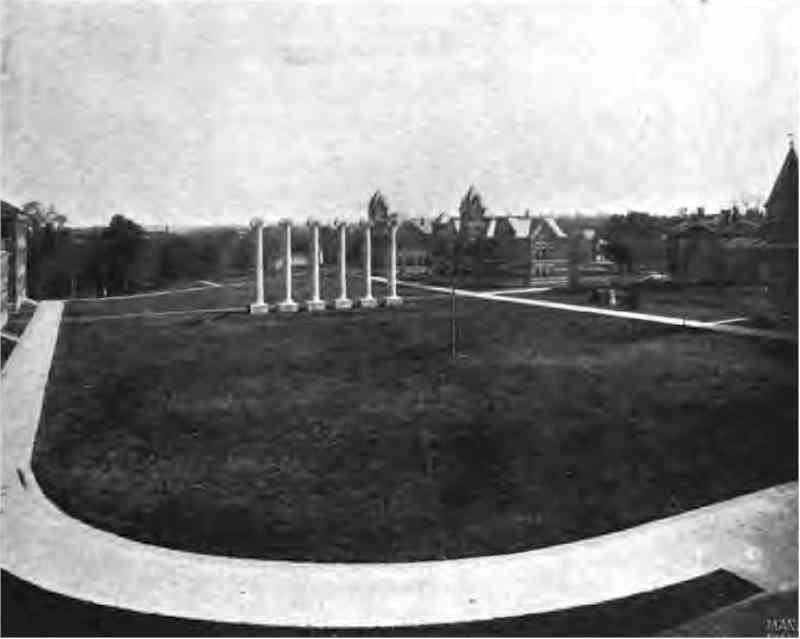
View of Missouri University
Campus, Showing old Columns
The Old Building
No architect of today could design a more beautiful building, and no contractor of today could construct a better building than did the architect and contractor of the university building of 1840. The contractor and his mechanics did not have any of the modern machinery for erecting buildings, but resorted to the old-fashioned methods. A tripod was made of sycamore poles and one rope and one pulley used to raise the three-foot blocks of native limestone that formed the old columns. Twenty oxen were attached to the other end of the rope; and as the oxen walked out toward town, slowly but surely the University of Missouri was erected. So well was the work of that day done, that the walls of the old building had to be blown down with dynamite after the fire in 1892; while most of the walls of the additions of 1885 tumbled down the night of the fire.
For nearly seventy-five years, the old columns, around which cluster memories so many and so pleasant, have stood amid storm and fire; and it is to be hoped that they will continue to stand and be the pivot, around which the students will march, play and give their stunts, year after year.
Rollins Aid Fund
The first person to give any money to the university after it was started was Dr. Anthony W. Rollins (father of Maj. James S. Rollins), and he gave ten thousand dollars, by his will, which was probated in 1845. The will provided that the county court of Boone county shall hold this sum in trust, and that the interest on it shall be used to aid worthy youths of Boone county in obtaining an education at the university. Some years ago, the county court resigned as trustee, and I. O. Hockaday was appointed and acted until his death in 1907; and the Boone County Trust Company was then appointed. This fund now amounts to about $51,000, and has been of assistance to hundreds of young men and young women.
Maj. James S. Rollins expressed the intention of establishing six scholarships in the university, but on account of his poor health, failed to make provision for that in his will. But after his death (which occurred on January 9, 1888) his children remembered what was their father's wish, and gave $6,000 to the university, and the same has been used for that purpose ever since, and is known as Rollins Scholarships.
In 1882, Major Rollins gave to the university the college bell which has always been on top of the building known as Science hall, now known as Switzler Hall. On this bell is appropriately inscribed the following:
"Ring out the old, ring in the new.
Ring out the false, ring in the true.
"
The Campus - University's Poverty
For many years, the front campus of the university was kept just as nature kept it, a beautiful blue grass lawn, with stately elm, ash, walnut, hickory, sugar maple, and cotton wood trees growing on it. About 1871, a pond was dug in front of the main building, and it was surrounded with flowers, flags and bushes; it was named "Lake St. Mary" in honor of President Read's daughter. Three or four skiffs were on the pond, and furnished entertainment for the students in pleasant weather, and the ice on the pond furnished entertainment in. winter time. This lake performed another service, it was a repository for the old cannon every Halloween night.
The back campus was used by President Read and President Laws as a pasture for their horses, cows, calves and colts. And in 1866, so Samuel H. Baker says, the back campus was rented to Judge Warren Woodson, and he had the whole of it planted in corn. Another Columbia gentleman said that in 1844, he got permission from the president to keep his calf in the front campus, which then had a good fence around it, and every day he visited the front entrance on Eighth Street, and fed his calf a pan of meal.
The poverty of the university is well illustrated by the fact that Doctor Lathrop, who was president of the university from 1840 until 1849, and then again from 1865 till his death in 1866, donated to the university a part of his salary.
The poverty of the university is further illustrated by this circumstance, which was told by Prof. Joseph Ficklin, head of the mathematical and astronomical departments for many years. When Professor Ficklin first came to the university in 1865, he found one of the shutters on the observatory had a broken hinge and there was no money in the university treasury to pay for a new one. So he got a Columbia blacksmith to mend the hinge and paid him by allowing him to look through the telescope at the moon.
During the Civil War
In the year 1862 the Federal forces took possession of the university building, and occupied it for some months; the south campus was used for their horses.
The room on the third floor of the main building was used as a prison for the confinement of captured Confederates; and, at one time some ten or twelve prisoners were confined there, and among the number a former member of the Athenaean society. He remembered the situation of the rooms and his old society hall just below him, and he procured a knife from his mother, who visited him. Then he succeeded in cutting a hole in the floor and through the ceiling in the old Athenaean hall, swung himself down into it and passed through into the gallery of the old chapel. There, he swung down to the first floor and then out of the window to the ground, and escaped with his fellow prisoners. After this Gen. Lewis Merrill, the commandant of the post, took possession of that society hall for his headquarters, and used it as such for some time.
For some months during the Civil war, the university was closed, the only time that its exercises have been suspended.
President's House Burned
In November, 1865, the president's house on the university campus was burned. The fire probably was the result of a defective flue. The legislature, after much hesitation, appropriated ten thousand dollars to rebuild this house, the first money the state ever appropriated for the university. After the fire, President Lathrop and family moved to the frame building which stood near the north line of the campus, known as the Model School, and afterwards as the School of English. Here President Lathrop lived until his death.
Agricultural College
In February, 1870, the general assembly passed an act establishing the Missouri Agricultural College, and locating it in Columbia, in connection with the university. Much of the credit for this legislation is due to the active work of James S. Rollins, then state senator, and Col. F. T. Russell, then representative from Boone County. The act was passed, on condition that Boone County would purchase and pay for a suitable farm for the college. Accordingly, meetings of citizens were held, and Boone County appropriated eighty thousand dollars, and Columbia appropriated ten thousand dollars, which money was used to purchase a farm of 640 acres situated south and southeast of Columbia. President Wm. W. Hudson having begun the erection of a large dwelling on a piece of land on the east side of the Columbia and Ashland gravel road, and died before finishing it, that property was purchased by the state, and the building completed and called the "Hudson Mansion." This building was destroyed by fire several years ago, and a handsome stone farmhouse has been erected in its place, and is now used by the dean of the college.
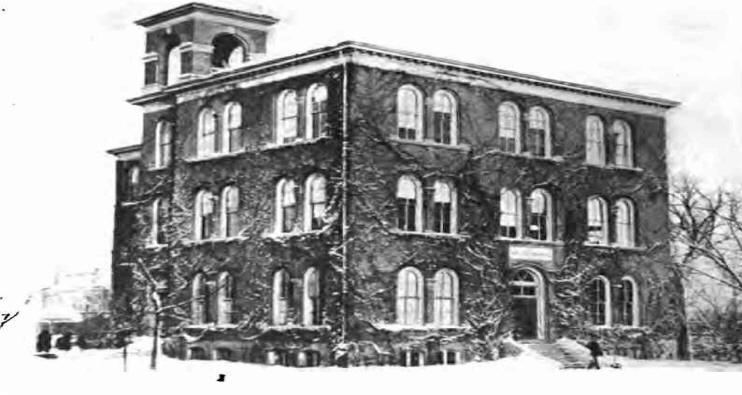
Switzler Hall
Pictures of Governor McClurg and all the members of the general assembly that established the Agricultural College were procured, framed and placed in the university library.
Corner Stone of Scientific Building
The building known as the Scientific building was for many years devoted to the chemistry department on the first floor, the agricultural and geological departments on the second floor, and the mathematical department on the third floor. It was afterwards called the Agricultural building, and is now used by the School of Journalism, and called Switzler Hall, in honor of Colonel Switzler, the lifelong friend of the university and an active journalist for so many years.
The comer stone, of this building was laid on commencement day, June 28, 1871, the ceremonies being in charge of the Masons of Columbia. Governor B. Gratz Brown and Mayor Barrett, of St. Louis, made the speeches of the occasion, and the usual amount of bunting and flags were in evidence. Governor Brown spoke of the value of a school of agriculture to the farmers of Missouri, and predicted that someday its value would be felt and appreciated. As was customary, the ladies of Columbia served dinner on the campus, and each lady tried to outdo her neighbor in the number of cakes, pies and other good things furnished.
Dedication of University Additions
June, 1885, was a great month in the history of the Missouri University, as the new wings, or additions to the main building, were dedicated, Dr. S. S. Laws presiding. Dr. W. Pope Yeaman, Missouri's greatest pulpit orator, delivered the baccalaureate address; Judge A. W. Terrill, of Texas, a graduate of the class of 1846, delivered the address to the literary societies; Stephen B, Elkins, afterwards secretary of war and United States senator from West Virginia, delivered the address to the alumni; and Senator Geo. G. Vest delivered an address on commencement day, on Thomas Jefferson, at which time the marble tablet from the Jefferson monument was unveiled. Secretary of State Thos. F. Bayard and Commissioner of Agriculture Norman J. Colman accompanied Senator Vest to Columbia, and also spoke in the new chapel. Among the distinguished guests present on that day were Governor John S. Marmaduke, Mayor David R. Francis, and Congressmen Wm. J. Stone and John T. Heard. The keys of the building were delivered by Governor Marmaduke to Major Jas. S. Rollins, president of the board of curators, and by him accepted in a most eloquent speech, perhaps the last public address delivered by him. During that commencement, a bronze bust of Major Rollins was presented by Col. John F. Williams, in behalf of the alumni, and placed in the new library, where it remained till the university fire of 1892.
Among the academic graduates of that year were Wm. A. Rothwell, of Moberly, Thomas L. Rubey, of Lebanon, and Prof. W. S. Dearmont, of Cape Girardeau. The Missouri Press Association held its annual session in Columbia at that time, and many of the leading newspaper men of our state were in attendance. The Columbia Herald, always an enterprising journal, printed a mammoth edition the week following, giving full accounts of the occasion, which was a credit to the editor of that paper, E. W. Stephens, and to everyone connected with it.
Celebration op Fiftieth Anniversary
On July 4, 1890, the semi-centennial of the laying of the corner stone of the university was celebrated in Columbia. It was the intention to have Maj. Nathaniel W. Wilson, Gen. John Ellis and Jacob S. Johnston, who acted as marshals on July 4, 1840, to act as honorary marshals; but the death of Major Wilson the week before, prevented carrying out of the original plan. The other gentlemen named were present, and occupied seats on the rostrum. The ceremonies were of the most interesting and imposing character. The town and university were profusely decorated with bunting and other appropriate insignia; a long procession of citizens on horseback, headed by the governor, secretary of state, treasurer and attorney-general, and the surviving donors of 1839, paraded our streets and marched over to the university campus, amid the firing of cannons and the playing of three brass bands. To some extent, the procession resembled the one that marched in Columbia just fifty years before. A magnificent barbecued dinner was served on the campus by the ladies of Columbia to the many friends of the university from Boone County and from a distance; and that night the sky was made luminous by an elaborate display of fireworks.
Robert L. Todd, a member of the first graduating class, the class of 1843, acted as chairman of the day, Jas. C. Gillespy was grand marshal; and Gov. David R. Francis, acting president M. H. Fisher, Col. Wm. P. Switzler, Leonidas M. Lawson, Gardiner Lathrop, Judge B. M. Dilley and Judge John Kinton, the last three being members of the board of curators, entertained the crowd with speeches fitting for the occasion. Gen. Odon Guitar delivered the eulogy upon the men who subscribed to the raising of $117,900 in 1839; and he performed that duty, as usual, in a handsome manner. All of the subscribers to that fund who were still alive were given seats of honor on the platform, and many interesting incidents were told by them. Levi James, who was a drummer in the procession of 1840, was present at this celebration and rode in a carriage. Edward D. Henry exhibited at that time a trowel, which he used in doing the brick work on the building in 1840; and Dr. Wm. H. Duncan, a pioneer Columbia physician, presented the university a large pocketbook, which had contained, at different times, every dollar that was used to pay for the first university building, he being treasurer of the university for some years after its organization.
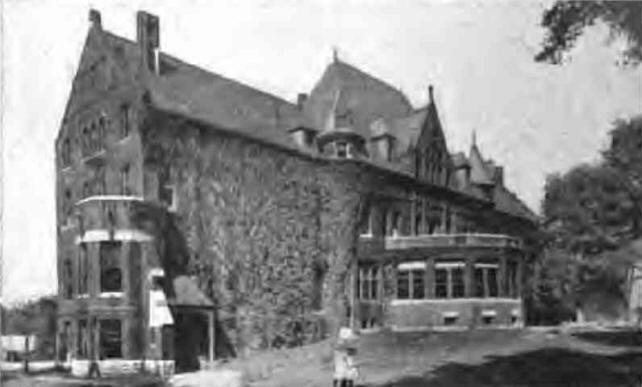
Lathrop Hall, Dining Club for
Students, University of Missouri
The annual meet of the League of American Wheelmen was held in Columbia on this day, and was attended by a number of men, and they entertained the large crowd at the Columbia fair grounds in the afternoon.
Burning of the University
Boone County, as the main building of the State University was burned that night. At about 7:30 preparations were being made for the annual exhibition of the Athenaean society in the university chapel, and as usual on such occasions, many people were on their way to the chapel. Some few had assembled in the chapel, including Prof. P. Pannell and the members of the University brass band. The falling of the large chandelier on the rostrum, the flashing of the electric lights and the darkness following was the first intimation of danger. It was soon discovered that the electric wires, that had been laid in 1885 between the floor of the library and the ceiling of the chapel, had set fire to the building near the northeast corner. A strong wind from the northeast swept the flames through the building, which was anything but fireproof; and soon all hope of extinguishing the fire was abandoned. Much of the class room and laboratory apparatus, all of contents of the library and many valuable books, pictures, documents and relies of the university were destroyed. The students, members of the faculty and citizens of Columbia worked heroically, trying to save the building, but their efforts were in vain.
At once, there was talk of the students leaving for home, but Dr. R. H. Jesse, who was president from 1891 till 1908, the right man in the right place, called a meeting of students and citizens for Sunday morning at 9:30 at the Haden opera house. All churches and Sunday schools gave up their services to this meeting, which lasted till noon. After stirring talks from Dr. Jesse and other members of the faculty, citizens and students, a vote was taken and every student agreed to remain. Invitations were received from the various religious denominations of Columbia, offering the use of their churches, from the county court, offering the use of the courthouse, and from the owners of some vacant store rooms. The teachers and classes had rooms and hours assigned to them, and on Monday morning every class was conducted the same as if nothing had happened.
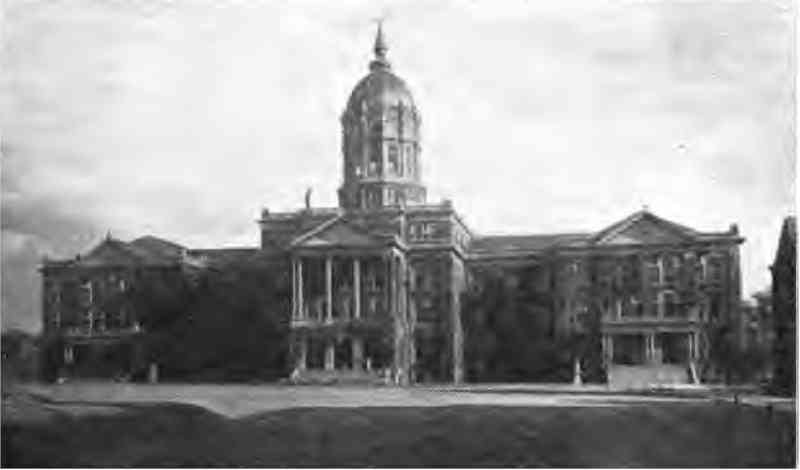
Academic Hall, University of
Missouri
It is a fact worthy of mention that the first entertainment ever held in the university chapel at night was an exhibition of the Athenaean society, and the old building burned on the night of an exhibition of the same Society.
A special session of the Missouri General Assembly created considerable uneasiness in Boone County, as an effort was made by Sedalia, Clinton and other enterprising towns to have the university removed. But with the aid of Governor Francis and other friends of the university and especially after Boone County raised fifty thousand dollars and gave to the state, the university was relocated in Columbia. The legislature made appropriation at that session for rebuilding the university, and, as has often been expressed, "the new university rose phoenix-like from the ruins." So the burning of the university building, which so many feared would be the destruction of the university itself, proved to be a blessing in disguise. The old columns, which stood in front of the portico of the old building, are now appropriately called "The connecting link between the old and the new university."
Manual Training Building Burned
There have been three fires on the university campus, only three in seventy-three years. In March, 1911, the Manual Training Building caught fire at midnight, from some cause unknown, and was almost destroyed. The valuable machinery, drawings and material in it were burned. A part of the building has been repaired and is now used.
The University of Today
Under the admirable administrations of former President R. H. Jesse and President A. Ross Hill, the university has grown to an enrollment of more than three thousand students, and every department is well equipped.
© Missouri American History and Genealogy Project
Created August 16, 2017 by Judy White
Source: History of Northeast Missouri, edited by Walter Williams, Volume I, Lewis Publishing Company, 1913
